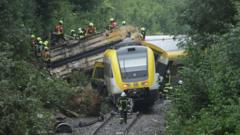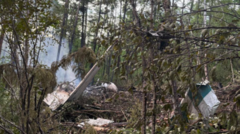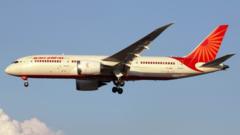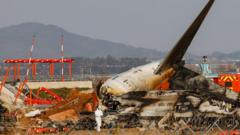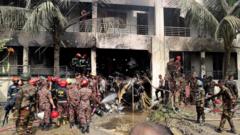Authorities in Ahmedabad are confronting significant hurdles as they coordinate the recovery and investigation of the tragic Air India crash that resulted in over 200 fatalities. Experts emphasize that the precariousness of the impacted buildings poses a serious risk to both victims' recovery efforts and the scrutiny required to uncover the cause of the tragedy.
Air India Crash: Recovery Efforts Face Challenges Amid Risks in Ahmedabad

Air India Crash: Recovery Efforts Face Challenges Amid Risks in Ahmedabad
Investigation and recovery operations for the deadly Air India crash may be prolonged due to unstable structures and potential gas leaks.
Emergency medical teams are racing against time to stabilize the collapsed structures that were hit by the aircraft shortly after its takeoff. Shawn Pruchnicki, an aviation expert at Ohio State University, indicates that the recovery process could extend over a month, highlighting the importance of not only retrieving victims but also ensuring the safety of rescue operations in the proximity of potentially unstable buildings.
The immediate focus of recovery teams will revolve around searching for survivors who might have been inside the struck buildings when the Boeing Dreamliner crashed. Large sections of the aircraft, particularly the tail, are entangled in the debris, complicating rescue efforts. Emergency responders may require heavy machinery, including cranes, to carefully extract parts of the aircraft without further compromising the structural integrity of the damaged buildings.
Besides immediate recovery actions, investigators will need a secure environment to examine the debris effectively and uncover important evidence that could explain how the aircraft went down. Central to this investigation is the retrieval of the flight's black box, which houses critical flight data and cockpit recordings; however, that process will only commence after the buildings are deemed secure, according to Mike Boyd, an aviation expert at Boyd Group International.
The urban landscape of Ahmedabad adds another layer of complexity to the disaster response. The dense population increases the number of potential casualties and exacerbates the damage inflicted on infrastructure, while also heightening the risk of ruptured gas lines that could lead to further tragedy.
The challenges facing authorities are substantial as they navigate the delicate balance between swift recovery and the need for thorough investigation in the aftermath of this devastating crash.
The immediate focus of recovery teams will revolve around searching for survivors who might have been inside the struck buildings when the Boeing Dreamliner crashed. Large sections of the aircraft, particularly the tail, are entangled in the debris, complicating rescue efforts. Emergency responders may require heavy machinery, including cranes, to carefully extract parts of the aircraft without further compromising the structural integrity of the damaged buildings.
Besides immediate recovery actions, investigators will need a secure environment to examine the debris effectively and uncover important evidence that could explain how the aircraft went down. Central to this investigation is the retrieval of the flight's black box, which houses critical flight data and cockpit recordings; however, that process will only commence after the buildings are deemed secure, according to Mike Boyd, an aviation expert at Boyd Group International.
The urban landscape of Ahmedabad adds another layer of complexity to the disaster response. The dense population increases the number of potential casualties and exacerbates the damage inflicted on infrastructure, while also heightening the risk of ruptured gas lines that could lead to further tragedy.
The challenges facing authorities are substantial as they navigate the delicate balance between swift recovery and the need for thorough investigation in the aftermath of this devastating crash.



